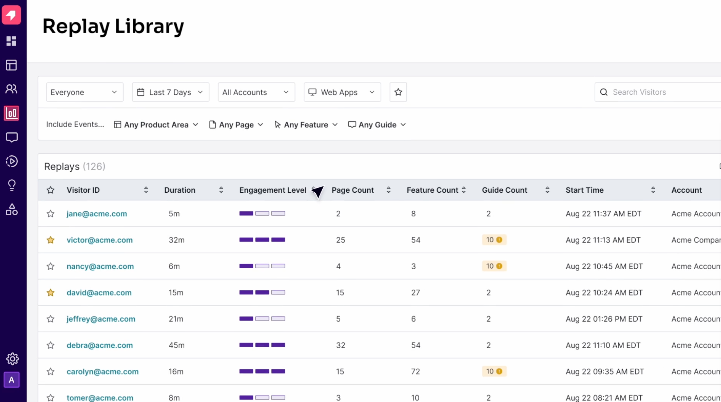ANALYSE EN PROFONDEUR - 16 min de lecture
Guide sur le déroulé des sessions utilisateur : définition, utilisations et avantages
Processus de capture des interactions d'un utilisateur avec un produit ou une application.
Aller plus loin
Table des matières
Qu'est-ce que le Déroulé des sessions utilisateur ?
Session replay refers to the process of capturing a user’s interactions with a product or application. Session replay tools allow product teams, UX designers, customer success managers (CSMs), sellers, marketers, engineers, and more to visualize how users interact with products and features, allowing them to better understand why users do what they do.
Différentes interactions des utilisateurs sont généralement capturées au cours d'une session, notamment les mouvements de la souris, les clics, les défilements et les saisies depuis un clavier. C'est un excellent moyen de suivre le parcours d'un utilisateur dans votre application et de voir exactement ce qu'il fait et comment il se comporte. Par exemple, si le curseur d'un utilisateur se déplace sur toute la page, mais qu'il ne clique sur rien, cela peut indiquer qu'il a du mal à trouver ce qu'il recherche. Ou si l'utilisateur clique frénétiquement sur un bouton ou une zone donnée du produit mais ne parvient pas à effectuer l'action souhaitée, il y a peut-être un bug dans le produit ou une inadéquation entre les attentes de l'utilisateur et la fonctionnalité.
Visual data in the form of session replays can help you gain context on the user experience (UX), get the evidence you need to influence internal teams and decisions, and even identify unexpected patterns in user behaviors. This gives you the complete picture of how your users are navigating and engaging with your app—helping you get even closer to your users and see beyond quantitative product data alone.
Session replays also add concrete visual evidence to support what you discover with product analytics. The combination of usage insights, user feedback, and replays of users’ in-app sessions is irrefutable. And it’s what you need to make the best decisions possible (and convince everyone else that they’re making the right decisions, too).
Quelle est la différence entre une carte thermique et un déroulé des sessions utilisateur ?
Qu'est-ce qu'une carte de chaleur ?
Les cartes thermiques sont des représentations visuelles de données qui illustrent l'intensité ou la concentration des interactions des utilisateurs dans votre application. Ces données sont représentées par des couleurs, montrant les zones où les utilisateurs passent le plus de temps, effectuent le plus d'actions ou passent le plus souvent leur curseur. En général, les couleurs plus foncées ou plus intenses représentent des zones d'utilisation plus intense. Il existe plusieurs types de cartes thermiques :
- Les cartes thermiques des clics indiquent les endroits où les utilisateurs cliquent le plus sur une page ou une application
- Les cartes thermiques de défilement indiquent jusqu'où un utilisateur fait généralement défiler la page
- Les cartes thermiques de mouvement montrent les zones dans lesquelles les utilisateurs déplacent le plus leur curseur
Heatmaps provide an aggregated view of user behavior, which can help teams identify popular or problematic areas on a page—but they don’t show the specific paths or actions users take. For that, you need session replays.
Comment fonctionnent les déroulés des sessions utilisateur
Les déroulés des sessions utilisateur consistent à enregistrer les interactions et les comportements réels d'un utilisateur au sein d'une application, d'un produit ou d'un site Web. Les outils de déroulé des sessions utilisateur, tels que Pendo Session Replay, capturent des informations détaillées telles que les mouvements de la souris, les clics, les défilements et les saisies au clavier. Vous pouvez ainsi obtenir une vision complète de ce que font les utilisateurs de votre produit et des problèmes qu'ils rencontrent.
Compared to heatmaps, session replays provide a more granular and individualized view of the user experience, and enable you to understand the complete flow of your users’ interactions and journeys.
Une combinaison d'outils tels que le déroulé des sessions utilisateur et les cartes thermiques est souvent utilisée pour l'analyse UX et la conception de produits. Associés à notre outil d'analyse produit, ils fournissent aux équipes produit toutes les informations dont elles ont besoin pour optimiser en continu l'expérience utilisateur.
Quelle est l'avantage des déroulés des sessions utilisateur et comment compléteraient-ils mes données quantitatives et qualitatives sur les produits ?
Using a session replay tool in conjunction with quantitative product analytics and qualitative customer feedback—particularly in a single platform like Pendo—is the best way to get the full picture into your users’ app experiences. Here are a few ways leveraging quantitative, qualitative, and visual data together can add value to your business.
Obtenez une représentation visuelle de la façon dont les utilisateurs interagissent avec votre application en temps réel
Visual data (in the form of session replays) complements product analytics by allowing you to actually see your users’ actions behind their data—so you can then take action, fast.
For example, if your product data indicates low usage for a key feature in your product, you might use a tool like Pendo Analytics to evaluate the paths your users are taking to get to that feature. Then, you could use Pendo Session Replay to watch their sessions and uncover clues about why their usage is low. By watching these replays, you might discover that the majority of your users are struggling to complete the last step in a workflow involving the feature. With this insight, you could deploy an in-app guide to steer them in the right direction and later use your findings to inform more holistic user interface (UI) updates.
Identifiez les difficultés et les problèmes
Session replays help identify specific pain points and areas of friction in the user journey. By watching real user sessions, you can uncover usability issues, confusing interfaces, or broken features that might not be evident through analytics alone. Session replays also allow you to understand the qualitative aspects of your users’ behavior. They give you the ability to see the exact sequence of actions users take in your app, the paths they follow, and the decisions they make—empowering you with valuable insights to make your UI more intuitive.
Validez les données d'analyse et vérifiez les hypothèses
Imaginez qu'il existe une tendance ou une anomalie inattendue dans les données de votre produit, ou que vos données montrent que vos utilisateurs font quelque chose d'inattendu avec une fonctionnalité particulière de votre produit. Les déroulés des sessions utilisateur peuvent vous aider à comprendre pourquoi vos utilisateurs se comportent d'une certaine façon et vous fournir des preuves visuelles pour déterminer si leurs actions correspondent au design et au fonctionnement prévus de cette fonctionnalité (ou si des modifications sont nécessaires).
De même, si vous avez des hypothèses concernant le comportement des utilisateurs ou des problèmes potentiels sur la base de ce que vous constatez dans vos données d'analyse ou de commentaires, vous pouvez utiliser les déroulés des sessions utilisateur pour les confirmer, ou non. Les déroulés des sessions utilisateur vous permettent de voir si les utilisateurs rencontrent les problèmes que vous suspectez et peuvent vous aider à vérifier si vos hypothèses correspondent aux actions réelles des utilisateurs.
Améliorez la recherche UX et les retours des clients
While customer feedback highlights concerns or suggestions, session replays provide a concrete illustration of those issues in action. This visual evidence can be valuable when communicating findings to stakeholders and development or enablement teams. Plus, combining session replays with product analytics and feedback helps create a continuous loop for iterative product improvements. It empowers teams to make data-driven decisions, backed by the visual proof they need to prioritize features or optimizations on the roadmap.
Quelles équipes bénéficieront le plus d'un outil de déroulé des sessions utilisateur et quels sont les cas d'utilisation les plus courants ?
Les équipes de toute organisation peuvent bénéficier de l'utilisation d'un outil de déroulé des sessions utilisateur, en particulier en combinaison avec des données quantitatives et qualitatives sur les produits. Voici quelques exemples de groupes qui tireront profit de l'utilisation des déroulés des sessions utilisateur dans leur travail, ainsi que les cas d'utilisation qu'ils ont découverts pour Pendo Session Replay.
Équipes de gestion de produit
With session replays, product managers can gain insights into how users move through their products, where they might be encountering challenges, and how exactly key features are being utilized. This information not only provides clear direction on immediate fixes that might be needed (whether to the product’s UI or with in-app guidance and enablement), but also aids in longer-term roadmap planning, feature prioritization, and development initiatives.
Équipes design produit et expérience utilisateur
User experience (UX) and product designers can use session replays to understand how users interact with specific design elements within an app. For example, if they’re unsure about the placement of a button, watching targeted session replays can show a designer where users seem to be lingering or “searching” for it with their cursor. That way, they can make an informed decision about where to position the button for the most intuitive user experience. Session replays can also help UX researchers and designers identify more general usability issues, based on where users go in the product or where they’re struggling to complete workflows.
Équipes de développement, d'ingénierie et d'assurance qualité
Developers and engineers can use session replays to identify or troubleshoot specific user issues without needing to try to replicate the problems themselves first. With the visual evidence to see exactly where and how a user got stuck, or where they encountered an error, engineers and quality assurance (QA) specialists don’t need to waste time recreating the issue in their own environments before developing a solution. This saves them valuable time and resources, and streamlines the entire QA process. These teams can also use session replays to confirm their hypotheses about glitches, validate user-reported bugs, and improve any number of technical aspects of the product.
Équipes d'assistance et de réussite client
De même, les équipes d'assistance client peuvent utiliser les déroulés des sessions utilisateur pour mieux comprendre les problèmes de leurs clients, voir les problèmes signalés en action et fournir une assistance plus ciblée et plus efficace. L'accès aux déroulés des sessions utilisateur améliore également la proactivité des responsables de la réussite client. Avant de s'entretenir au téléphone avec les clients, ils peuvent examiner les déroulés du compte pour voir si le client rencontre des difficultés avec certaines tâches, ou identifier les domaines du produit dont le client ne bénéficie pas encore. Les directeurs marketing sont donc davantage préparés et autonomes lors des conversations avec leurs clients, et améliorent la satisfaction et l'opinion des clients.
Plus, session replays are a valuable tool for optimizing product-led conversions (e.g. in-app upsells or cross-sells). By analyzing user interactions on key conversion pages or premium features, CSMs can proactively identify areas to focus on in upcoming calls and bring in the necessary support to make the expansion a no-brainer for their customer.
Équipes des ventes et d'ingénierie commerciale
Sales teams can also realize huge benefits from using a session replay tool. During the evaluation and trial process, sellers can use a tool like Pendo Session Replay in any demo environments they set up for their prospects. This gives them valuable insight into the areas of the product their prospects might be most interested in, which opens the door for more meaningful deal conversations and increases the likelihood that the seller will help the prospect reach their defined success criteria before the trial period ends.
Pour les ingénieurs commerciaux, ce type de preuve visuelle constitue un moyen efficace de résoudre de manière proactive les problèmes que le prospect pourrait rencontrer pendant sa période d'essai, plutôt que de perdre un temps précieux à essayer de résoudre les problèmes en direct.
Pourquoi ai-je besoin d'une solution de déroulé des sessions utilisateur ?
In combination with product analytics, in-app guidance, and product discovery solutions, session replays allow you to see exactly how your users interact with your product or application. This insight is invaluable for optimizing the user experience, identifying usability issues, and making informed roadmap or design decisions.
Les informations fournies par les déroulés des sessions utilisateur aident également les équipes de votre entreprise à mieux comprendre les comportements des utilisateurs et des clients, notamment la façon dont ils naviguent dans votre application, où ils passent le plus de temps et les actions qu'ils entreprennent. Grâce à ces résultats, vous pouvez prendre des décisions fondées sur des données et allouer le temps et les ressources de manière plus efficace.

Quels sont les facteurs à prendre en compte lors du choix d'un outil de déroulé des sessions utilisateur ?
Tous les outils de déroulé des sessions utilisateur ne se valent pas. Au moment de prendre une décision, réfléchissez à la façon dont l'outil fonctionnera par rapport à l'utilisation qu'en aura votre équipe, s'il respectera les réglementations du secteur et comment il s'intégrera dans les technologies produit ou d'expérience in-app de votre entreprise. Voici quelques points importants à considérer.
Confidentialité et sécurité des données
Tenez compte de l'objectif et des fonctionnalités de base de votre application, ainsi que des informations que vos utilisateurs partagent lorsqu'ils l'utilisent. Par exemple, si vous exercez vos activités dans un secteur hautement réglementé (comme les domaines de la santé ou de la finance), vous ne devriez envisager que des outils de déroulé des sessions utilisateur avec des paramètres de confidentialité qui expurgent les informations sensibles des clients.
Assurez-vous que les fournisseurs que vous évaluez accordent la priorité à la confidentialité et respectent les réglementations pertinentes en matière de protection des données, telles que le RGPD et l'HIPAA. Vous devez également comprendre comment les données de vos utilisateurs seront collectées, stockées et traitées, et confirmer que le fournisseur que vous choisissez a mis en place des mesures de sécurité robustes pour la protection de toutes les informations sensibles collectées.
Pendo Session Replay was created with privacy as the number one priority. It includes three distinct, no-code privacy settings right out of the box (plus the option to customize those settings even further), so you can redact sensitive user information and only collect what you need. And because Pendo Session Replay seamlessly integrates with the rest of the Pendo platform, you can trust that your replay data will be protected by our best-in-class privacy and security policies and adhere to all regulatory schemes.
Nombre de déroulés et conservation des données
Some session replay tools only capture a selection of replays, while others—like Pendo Session Replay—capture all user interactions from the point of installation. It’s important to decide what matters most to your team and business. Do you want the ability to see every user interaction, so you never miss a critical insight for improving your product experiences? Or are you only looking for a small, randomized sample?
Prenez également en compte la durée pendant laquelle chaque fournisseur conserve ces déroulés. Certains outils permettent de personnaliser les périodes de conservation des données, tandis que d'autres peuvent avoir des politiques prédéfinies. Assurez-vous de choisir une solution dotée de politiques adaptées aux besoins et aux exigences de conformité de votre organisation.
Options de recherche et de filtrage
Examinez les options de recherche et de filtrage proposées par chaque outil que vous évaluez. Pour une analyse efficace, vous devez pouvoir compter sur la possibilité de rechercher facilement certaines sessions, de filtrer par attributs ou comportement de l'utilisateur et de segmenter les données. Grâce à Pendo Session Replay, vous pouvez :
- Marquer et mettre en avant les déroulés importants pour les identifier facilement, y revenir plus tard ou les partager avec d'autres membres de votre équipe
- Partager des déroulés avec votre équipe sur Pendo afin de développer l'empathie au sein de l'organisation
- Consulter une liste d'événements capturés dans un déroulé pour reconnaître rapidement d'autres fonctionnalités avec lesquelles l'utilisateur pourrait interagir
- Filtrer ou ignorer l'inactivité dans les déroulés afin de vous concentrer sur les parties actives de l'expérience utilisateur ou d'obtenir des indices visuels de l'inactivité pour diagnostiquer les problèmes dans le parcours
Intégration avec d'autres outils
Before committing to any new tool, it’s important to consider how it will integrate with your existing tech stack. Ideally, all your product data should live in a single, unified platform—so that it’s as complete and actionable as possible. Pendo Session Replay is part of the full Pendo platform. This means you can seamlessly move between digging into product analytics data, to watching replays associated with those insights, to taking action on your findings with in-app guides.
For example, if you use funnel reports in Pendo to identify where users drop off within an ideal user journey, with Pendo Session Replay, you can jump from that moment of drop-off directly to replays that illustrate why those users are dropping off. This allows you to act on a solution—fast.
Évolutivité et assistance
Prenez en compte l'évolutivité de chaque outil de déroulé des sessions utilisateur que vous évaluez. Assurez-vous qu'il peut gérer le volume de données générées par votre site Web ou votre application, notamment à mesure que votre base d'utilisateurs augmente. Veillez également à sélectionner un fournisseur qui vous donnera le niveau d'assistance client, de formation, de documentation et de conseils in-app dont votre équipe a besoin.
Pendo is built for and trusted by the world’s leading enterprise organizations. We take a comprehensive approach to your success and offer a number of support options to help your team realize the value of your investments.
Quelles sont les idées fausses les plus répandues sur les déroulés des sessions utilisateur ?
Session replays are just one important tool product teams should have in their app experience toolbox. But the real value of this kind of visual data is unlocked when it’s used in conjunction with quantitative product analytics and qualitative feedback data. Here are a few common misconceptions—and truths—about session replays.
Idée fausse : les déroulés des sessions utilisateur fournissent une compréhension complète de l'intention des utilisateurs
While session replays offer valuable insights into user actions and behaviors, they don’t reveal users’ underlying motivations or thoughts. It’s essential to supplement session replay data with other research methods and user feedback—along with objective product analytics—for a more comprehensive understanding of why users do what they do and how these actions impact overall product success.
Idée fausse : vous devez regarder chaque déroulé des sessions utilisateur
Particularly if your app has a large number of active users—and if your session replay tool collects a large volume of sessions—it’s impractical to watch every single recording. Instead, focus on targeted analysis, using search and filtering options to identify specific user segments or behaviors for closer examination. With Pendo, this entire process is connected: You can jump back and forth between product analytics data, customer feedback, and replays to explore seamlessly and get the insights you need quickly.
Idée fausse : les outils de déroulé des sessions utilisateur constituent une atteinte à la vie privée des utilisateurs
The best session replay tools—like Pendo Session Replay—prioritize user privacy and data compliance. Pendo Session Replay comes with three fully customizable privacy settings that allow teams to redact or mask sensitive user information. Pendo Session Replay is not a real-time monitoring tool. Session replays are captured during user sessions and only made available in Pendo Session Replay after they occur.
Quel est l'intérêt d'utiliser le Déroulé Pendo par rapport à d'autres solutions ?
Pendo Session Replay is useful at every phase of the product development life cycle—whether you’re discovering why users are stuck, evaluating adoption after a launch, iterating on legacy features that have low usage, or digging into specific segments of users to understand pains and needs. Pendo Session Replay is different from other session replay tools. It was designed with privacy as a top priority, with features to help you uncover insights fast.
- Le Déroulé Pendo propose toujours un nombre illimité de déroulés. Ainsi, votre exploration n'a pas de limite et vous en gardez le contrôle.
- Les déroulés sont organisés par segments, guides et données d'utilisation, ce qui vous permet de trier et d'accéder directement aux sessions les plus importantes pour vous et votre équipe.
- Comme Pendo Session Replay est intégré à la plateforme Pendo, vous pouvez accéder aux déroulés où que vous soyez dans Pendo. Passez du point de données au déroulé en un seul clic et visualisez les comportements qui se cachent derrière les données grâce à des guides in-app, à des analyses produit et à des cartes thermiques. (D'autres intégrations sont à venir.)
Consolidez les outils et créez une source unique de vérité
La véritable force de Pendo Session Replay réside dans son intégration parfaite à l'ensemble de la plateforme Pendo. Au lieu de passer par des outils disparates d'analyse produit, de feedback et de déroulé des sessions utilisateur pour obtenir les informations dont vous avez besoin, Pendo réunit toutes vos données quantitatives, qualitatives et visuelles. Lorsque toutes les données relatives au comportement des utilisateurs sont regroupées en un seul endroit, il est non seulement plus facile d'y accéder, de les partager et d'agir, mais il est également plus facile de s'y fier.
Using Pendo’s complete platform also eliminates the mental gymnastics (and technical headaches) of juggling multiple technologies, along with the added costs of enabling different tools across your organization. Consolidating all of your product experience tools and user behavior insights into a unified platform simplifies and streamlines your team’s workflows—reducing the mental load and additional costs that come with inflated tech stacks.
Découvrez comment le Déroulé Pendo informe votre feuille de route produit
Vous aimerez peut-être aussi

Introducing Pendo Session Replay: A new, privacy-first solution to understand user behavior with visual data

3 reasons why a session replay point solution doesn’t cut it


